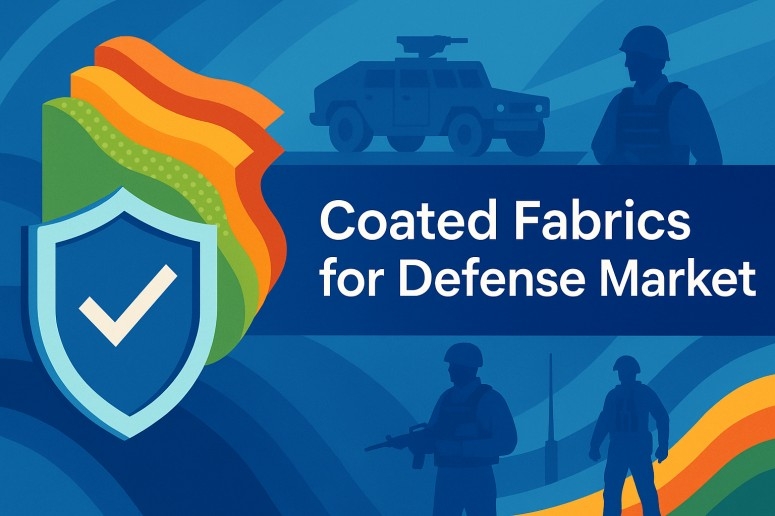Coated Fabrics for Defense Market In Depth Analysis, Growth Strategies and Comprehensive Forecast 2025 to 2035

The global coated fabrics for defense market is set to advance steadily between 2025 and 2035, fueled by rising defense budgets, new material innovations, and increased demand for lightweight, high-performance protective textiles. According to the latest market outlook, the industry will expand from USD 4,883.7 million in 2025 to USD 7,023.2 million by 2035, reflecting a CAGR of 3.7%.
This growth is creating new avenues not only for established defense textile leaders but also for emerging manufacturers looking to scale, innovate, and enter the defense supply chain with breakthrough technologies.
Explore Opportunities – Get Your Sample of Our Industry Overview Now!
https://www.futuremarketinsights.com/reports/sample/rep-gb-6762
Driving Forces Behind Market Expansion
Coated fabrics engineered technical textiles designed to withstand fire, water, chemicals, and extreme environments, are becoming mission-critical for defense applications. From ballistic vests and tactical uniforms to military shelters, vehicle covers, and chemical protection suits, these advanced fabrics are redefining how global defense forces operate and protect their personnel.
Rising threats of asymmetric warfare, terrorism, and chemical/biological attacks are accelerating demand for CBRN (Chemical, Biological, Radiological, Nuclear) protective gear. Additionally, innovations in nanotechnology, smart textiles, and high-performance polymer coatings are creating fabrics that combine multiple protections—such as flame resistance, waterproofing, and infrared suppression—into a single, lightweight solution.
Regional Market Dynamics
North America
North America remains the largest market for coated defense fabrics, supported by the U.S. Department of Defense’s continuous investments in soldier protection systems, body armor, and tactical shelters. Innovations in nanocoatings and integrated smart textiles are gaining momentum, offering fabrics with embedded sensors for real-time monitoring.
Europe
Europe is witnessing strong growth as NATO-led initiatives drive modernization of uniforms, vehicle covers, and protective gear. Nations such as Germany, France, and the UK are increasingly adopting infrared-reflective and flame-retardant textiles, while EU programs are pushing for eco-friendly, recyclable coatings.
Asia-Pacific
The Asia-Pacific region is projected to record the fastest CAGR, with China, India, Japan, and South Korea investing heavily in next-generation military textiles. India’s Make in India program is creating opportunities for local manufacturers, while Japan and South Korea lead innovations in wearable smart textiles.
Rest of the World
The Middle East is prioritizing heat- and flame-resistant fabrics for desert warfare, while Latin America is deploying coated textiles for anti-narcotics operations and border security. Africa is expanding demand through UN peacekeeping missions, focusing on cost-effective but durable military textiles.
Challenges and Opportunities for Manufacturers
While the market outlook is promising, manufacturers face challenges such as high production costs for advanced coatings and stringent compliance with NATO STANAGs, U.S. MIL-SPEC, and EU directives. These barriers raise entry costs for new players.
However, opportunities are abundant:
- Smart Textiles & Nanotechnology: Fabrics with embedded sensors and adaptive camouflage.
- Lightweight & Multi-Functional Fabrics: Combining ballistic protection, chemical resistance, and weatherproofing.
- Sustainability: Development of recyclable and bio-based coated fabrics aligned with global defense sustainability mandates.
Country-Level Insights
- United States: Growth driven by modernization programs and innovations in lightweight, sustainable textiles (CAGR: 3.9%).
- United Kingdom: Expansion in homeland security and adoption of smart, multi-layered fabrics (CAGR: 3.5%).
- European Union: Emphasis on eco-friendly coatings and joint defense programs (CAGR: 3.6%).
- Japan: Investments in wearable smart fabrics and anti-chemical coatings (CAGR: 3.4%).
- South Korea: Rise in nanomaterials and homeland security demand (CAGR: 3.7%).
Market Segmentation Highlights
- By Fabric Type:
- Polyester-coated fabrics are gaining traction for cost-effectiveness and weather resistance.
- Nylon-coated fabrics dominate tactical gear due to strength, flexibility, and abrasion resistance.
- By End-Use:
- The Army remains the largest consumer, followed by the Navy, which requires specialized fabrics for maritime environments.
Competitive Landscape: Opportunities for Established & Emerging Players
The global market is shaped by leading manufacturers but leaves ample room for agile new entrants.
Key Established Players:
- Trelleborg AB – Known for ballistic vests, NBC protection suits, and nanotech-driven coatings.
- Saint-Gobain Performance Plastics – Supplies PTFE and radar-absorbing textiles for stealth and extreme environments.
- Omnova Solutions Inc. – Specializes in polyurethane and PVC-coated fabrics for shelters and protective gear.
- Cooley Group Holdings, Inc. – Supplies reinforced coated fabrics for military boats and decontamination enclosures.
- Takata Corporation (Joyson Safety Systems) – Focuses on ballistic armor and AI-driven tactical textiles.
Rising Innovators & Growth Opportunities:
- Companies like Seaman Corporation, Spradling International, Serge Ferrari Group, Graniteville Specialty Fabrics, and Heytex Bramsche GmbH are expanding their portfolios with lightweight composites, UV-resistant fabrics, and modular military shelters.
- Emerging regional manufacturers in Asia-Pacific and Eastern Europe are expected to benefit from defense localization initiatives, offering competitive, high-performance alternatives to imports.
Checkout Now to Access Industry Insights:
https://www.futuremarketinsights.com/checkout/6762
About Future Market Insights (FMI)
Future Market Insights, Inc. (ESOMAR certified, recipient of the Stevie Award, and a member of the Greater New York Chamber of Commerce) offers profound insights into the driving factors that are boosting demand in the market. FMI stands as the leading global provider of market intelligence, advisory services, consulting, and events for the Packaging, Food and Beverage, Consumer Technology, Healthcare, Industrial, and Chemicals markets. With a vast team of over 400 analysts worldwide, FMI provides global, regional, and local expertise on diverse domains and industry trends across more than 110 countries.
- Questions and Answers
- Opinion
- Motivational and Inspiring Story
- Technology
- Live and Let live
- Focus
- Geopolitics
- Military-Arms/Equipment
- Segurança
- Economy
- Beasts of Nations
- Machine Tools-The “Mother Industry”
- Art
- Causes
- Crafts
- Dance
- Drinks
- Film/Movie
- Fitness
- Food
- Jogos
- Gardening
- Health
- Início
- Literature
- Music
- Networking
- Outro
- Party
- Religion
- Shopping
- Sports
- Theater
- Health and Wellness
- News
- Culture

